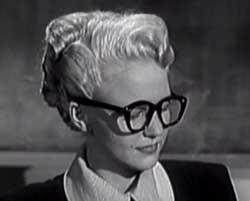 Seated at the teacher's desk on a school room set, Peggy Lee sings I Don't Know Enough About You (1951), with guitarist sitting in a corner on the dunce stool.
Seated at the teacher's desk on a school room set, Peggy Lee sings I Don't Know Enough About You (1951), with guitarist sitting in a corner on the dunce stool.
The guitarist is Dave Barbour, with whom Peggy composed this song, a moderate hit for 1946.
Since Dave is perched upon the dunce's seat, he's acting the fool, having pulled his pant legs up to show his ankles above his shoes.
He intentionally looks like a dork, but a dork who plays awfully well, with a pleasing if unshowy solo.
The book Peggy is reading at the start is Margaret Wise's The Golden Egg Book, hardly reinforcing the high school professorial setting, as it's a preschool classic.
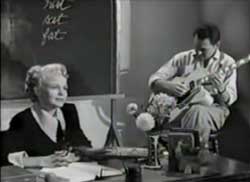 I suspect a family in-joke. When this Snader was filmed, Peggy & Dave's daughter Nicki would've been six, already a bit old for The Golden Egg Book, but it might've been Nicki's favorite for the previous couple years. I suspect a family in-joke. When this Snader was filmed, Peggy & Dave's daughter Nicki would've been six, already a bit old for The Golden Egg Book, but it might've been Nicki's favorite for the previous couple years.
Peggy's vocal styling on her & Dave's composition I Don't Know Enough About You is a throwback to the best of the swing band era's singers -- which she of course had been -- despite the scaled down instrumentation.
Her beauty, as well as the beauty of her sexily languid voice, makes this one of the greatest of the Snader transcription performances. Good song well sung, & such class in that class, I'm taking her course!
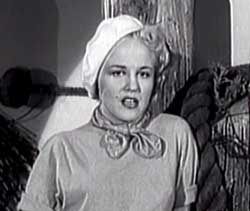 Peggy's collaborations with Dave Barbour began about 1944. The 1950/1951 Snaders are truly the ideal representations of her live shows when backed by the Dave Barbour Quartet. Peggy's collaborations with Dave Barbour began about 1944. The 1950/1951 Snaders are truly the ideal representations of her live shows when backed by the Dave Barbour Quartet.
Peggy & Dave met during her stint as Benny Goodman's singer, when Dave was Benny's guitarist.
As soon as they were married in 1943, Goodman fired Dave for disobeying a strict rule that band members not "fraternize" with the girl singer. Peggy quite naturally quit the band.
For about a year she "retired" & thought that raising their newborn daughter Nicki would be her primary task as homemaker thereafter, while Dave earned a living for the family as a studio musician.
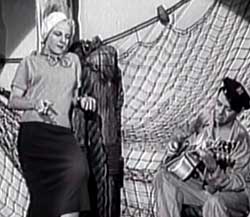 But she kept writing songs & ended up in the studio herself in recording sessions, producing a string of hits, but still without on-the-road performing. But she kept writing songs & ended up in the studio herself in recording sessions, producing a string of hits, but still without on-the-road performing.
Not until 1948 (with the slightly goofy mega-hit "Manana"), when she felt Nicki no longer required her full time attention, did Peggy again become a full-time performer.
In I Cover the Waterfront (1950), Peggy Lee is standing on a set decked out to look like a pier. Dave Barbour is seated nearby playing his guitar. Peggy sings it not as jump-jazz as Satchmo sang it but as a slow blues piece.
It's a sultry insinuating performance. Frankly, the setting makes it look like she's there selling BJs to sailors. Which is sexy either in spite of or because it's awfully dirty, but the seediness somewhat undermines a truly original local interpretation, one of the greatest the number ever received.
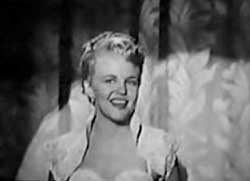 Peggy Lee again appears with the Dave Barbour in Why Don't You Do Right? (1951). Peggy Lee again appears with the Dave Barbour in Why Don't You Do Right? (1951).
In the opening shot we see Peggy across the room, & in the foreground is the Dave Barbour Quartet plus piano.
The scene then cuts to Dave with a small guitar solo leading to Peggy's vocal. He'll have a bigger & very fine solo at the break, with Peggy watching him intensely. At the second break we get a piano solo, simple & elegant.
The classic tune, with lyrics that are referencing the Depression Era, is delivered with vocal brilliance & sexy wit:
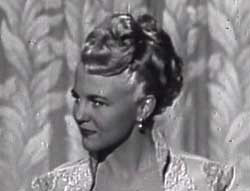 "You had plenty money 1922/ You let other women make a fool of you/ Why don't you do right, like some other men do/ Get out of here, get me some money too." This is Peggy Lee at her prime, & you gotta go back to singers like Billie Holiday to find this level of great. "You had plenty money 1922/ You let other women make a fool of you/ Why don't you do right, like some other men do/ Get out of here, get me some money too." This is Peggy Lee at her prime, & you gotta go back to singers like Billie Holiday to find this level of great.
The song originated in 1936 as "The Weed Smoker's Dream" recorded by Harlem Hamfats. But its author, Joe McCoy, husband of the great blueswoman Memphis Minnie, reworked the tune & lyrics for Lil Green, who recorded it in 1941.
Peggy was a a huge fan of Lil Green & listened to Lil's recording in her dressing room, loving it & learning from it as a kind of warm-up before going on stage with Benny Goodman.
Benny, hearing the song from Peggy's room so often, asked her if she'd like it if he had an arrangement done for her, & she was thrilled.
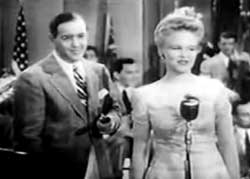 A year after Lil Green's original version, Peggy recorded it anew with Benny Goodman. A year after Lil Green's original version, Peggy recorded it anew with Benny Goodman.
It's an even better performance than on the later telescription, because she always responded so well to her environment, & the Goodman orchestra provided an unbeatable framework for her voice.
The clip is circulating separately as a soundie of Benny & Peggy doing Why Don't You Do Right (1943). But it's not really a soundie; it is excerpted from the feature film The Powers Girl (1943).
Most soundies were original & complete short-short films the length of a single song, but a few, especially in 1943 when there was a filmstock shortage during the war, a number of soundies were indeed excised from longer featurettes or from full length feature films. So perhaps this was also a soundie, but I can't find that it was ever used as one in a Panoram jukebox.
Though probably never used as a separate film, the clip is fun to compare to the telescription as it encapsulates Peggy's changing style with & without big-band backup. Benny's clarinet solo is first-rate.
It was a giant hit for Peggy & Goodman, & short her to national fame, more so than happened for the majority of big band singers who remained overshadowed by the starring orchestras.
Now & then a singer far outpaced the orchestra, & giant that Benny was in the industry, he'd nevertheless face that wall in the 1950s when rock n roll pretty much put the nail in the coffins of big bands -- at a time when Peggy's star continued to shine most brightly.
Here at the beginning of that illustrious career, Peggy's performance with Goodman band, without being showy, has a more up-tempo feel to it than in the Snader telescription, she having become a more languid insinuating singer as a solo act. That change would lead inevitably to her ultra-sexpot classic take on "Fever" with some added lyrics of her own.
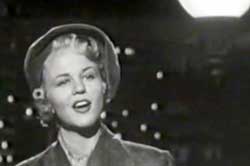 Again Dave Barbour backs up Peggy on the Snader telescription of the Harry Warren & Al Dubin classic I Only Have Eyes for You (1950). This one places Peggy on a stage that recreates a night scene overlooking the city. Again Dave Barbour backs up Peggy on the Snader telescription of the Harry Warren & Al Dubin classic I Only Have Eyes for You (1950). This one places Peggy on a stage that recreates a night scene overlooking the city.
The song is perhaps just a little too standard & common, but there's just no denying Peggy was a fine, fine singer, & she gives the number a heightened sexiness.
Generally Peggy truly "becomes" what she is singing. Her persona surrounds the lyrics & for the length of the song, at least, it's hard to imagine anyone else ever sang it at all, let alone so well. But this one, I never cease to see it done by Dick Power & Ruby Keeler in Dames (1934), or I hear the Platters, & most especially the Flamingos' versions. Peggy just never quite owns this one.
Nevertheless, even with such a proviso, when she sings the lyric, "I don't know if we're in a garden or on a crowded avenue," her languid voice & pose makes her oh so desirable. She was as sexy as ever a singer could get. And that Dave Barbour was a lucky bastard.
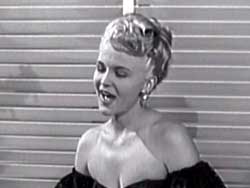 Oddly, even clumsily staged with piano & Quartet stage right & Peggy Lee seated far away as though in a living room, on a sofa, doing some needlework. Oddly, even clumsily staged with piano & Quartet stage right & Peggy Lee seated far away as though in a living room, on a sofa, doing some needlework.
Dave approaches the sofa, insinuating his guitar-playing upon her, & she looks up from her sewing & begins to sing I May Be Wrong (1950):
"I may be wrong but I think you're wonderful/ I may be wrong but I think you're swell/ I like your style, say, I think it's so marvelous/ But I'm always wrong so how can I tell..."
Her voice is right but for once Dave Barbour's quartet is just the wrong kind of instrumentation, & the song comes off trivial. A sax could've inspired greater liveliness from Peggy & this could've been a nice bit of jump-jazz with the usual humor of jump-jazz lyrics, but her it comes off just a hair too laid back.
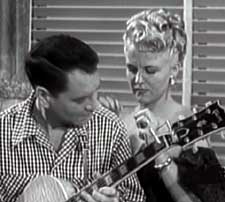 At the instrumental break Dave dominates with his guitar while Peggy stands up & fusses about him like a wife would, sewing his collar because of the lyric "all of your shirts are unsightly." At the instrumental break Dave dominates with his guitar while Peggy stands up & fusses about him like a wife would, sewing his collar because of the lyric "all of your shirts are unsightly."
She's ultimately such a wifey-wifey in this one that she loses her sexiness, like a domesticated tigress trained to balance a penny on her nose.
The song was written by Henry Sullivan & Harry Ruskin in 1929, & had been covered very often as a standard, including by Count Basie, Miles Davis, Hoagy Charmichael, June Christy, Judy Garland, Chubby Checkers, the Orioles, Charlie Parker, Dinah Shore.... And frankly, nobody else made it feel like a runaway classic either.
Still & all, if this were assessed as the weakest of the Snaders for Peggy Lee, that's still a damned high standard.
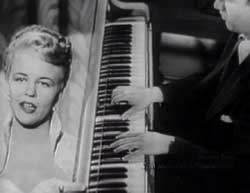 After preliminary portraits of the Quartet in the Snader telescription What More Can a Woman Do? (1950), Peggy begins the song written by herself & Dave Barbour: After preliminary portraits of the Quartet in the Snader telescription What More Can a Woman Do? (1950), Peggy begins the song written by herself & Dave Barbour:
"If he told me that i should steal/ I guess I would, the way I feel/ For this is one thing I know is real/ What more can a woman do?
"And if he told me that I should lie/ I guess at least I'd have to try/ Cause it's for him I live or die/ What more can a woman do?
"It's just another story of Jim or Bill or Joe/ But when you really love your man, you gotta let him know.
"If he told me that i should leave/ That's only one thing I can't conceive/ I'd rather give & not receive/ What more can a woman do?"
The lyric is great, & the quartet is right for the number. Peggy gives a completely unadorned rendition, letting the song speak for itself, & she's just so endearing in her expression of devotion.
Though Snader telescriptions were issued primarily for television play, as the equivalent of records played on the radio, Peggy's were additionally apportioned between two 16 mm "sets" & distributed to theaters as musical featurettes in days when a trip to the cinema got you a lot more than just a feature film.
copyright © by Paghat the Ratgirl
|
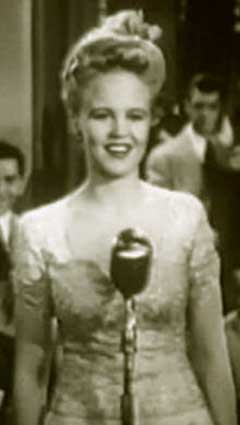

 I suspect a family in-joke. When this Snader was filmed, Peggy & Dave's daughter Nicki would've been six, already a bit old for The Golden Egg Book, but it might've been Nicki's favorite for the previous couple years.
I suspect a family in-joke. When this Snader was filmed, Peggy & Dave's daughter Nicki would've been six, already a bit old for The Golden Egg Book, but it might've been Nicki's favorite for the previous couple years.
 But she kept writing songs & ended up in the studio herself in recording sessions, producing a string of hits, but still without on-the-road performing.
But she kept writing songs & ended up in the studio herself in recording sessions, producing a string of hits, but still without on-the-road performing.
 "You had plenty money 1922/ You let other women make a fool of you/ Why don't you do right, like some other men do/ Get out of here, get me some money too." This is Peggy Lee at her prime, & you gotta go back to singers like Billie Holiday to find this level of great.
"You had plenty money 1922/ You let other women make a fool of you/ Why don't you do right, like some other men do/ Get out of here, get me some money too." This is Peggy Lee at her prime, & you gotta go back to singers like Billie Holiday to find this level of great.


 At the instrumental break Dave dominates with his guitar while Peggy stands up & fusses about him like a wife would, sewing his collar because of the lyric "all of your shirts are unsightly."
At the instrumental break Dave dominates with his guitar while Peggy stands up & fusses about him like a wife would, sewing his collar because of the lyric "all of your shirts are unsightly."